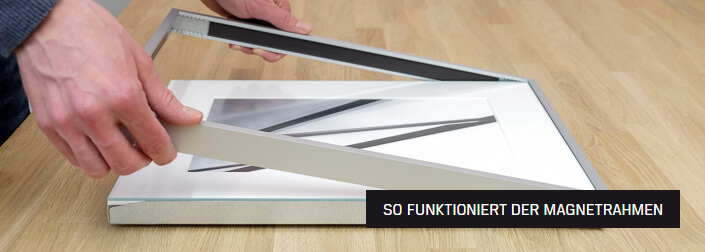Frame workshop - Buy picture frames online at HALBE-rahmen.de
In the frame workshop of HALBE frames you too can have your frame made entirely according to your own wishes. You decide which colour the frame has, which material it is made of and how thick the Frame profiles should be. Thus each picture frame is an individual piece, which depends completely on your desires.
Find the right frames for your pictures. Whether you are looking for a classically simple wooden frame or a magnetic frame made of aluminium - at HALBE frames we place great emphasis on variety. Whether with or without passepartout, in portrait or landscape format: you decide which frame you would like. Visit our online shop for picture frames and more and be your own frame designer.
Frame production between technology and art
The technique and art of making picture frames has a long tradition. From the very beginning, picture frames had the function ofdecorating a painting. In the Middle Ages and in modern times, a lot of time was invested in making picture frames. Since paintings were commissioned by kings, princes, nobles and the church at that time and were very expensive, great importance was also attached to contemporary framing appropriate to the means. These were produced in frame workshops and designed to match the painting. In the course of the centuries different styles developed, which had a significant influence on the form, material and structure of a picture frame . Thus, in the Biedermeier period (1815-1848), the trend emerged to have picture frames made predominantly of dark mahogany. The frames were classically simple in design, had clean lines and no ornamentation. A different picture emerges in the era of Art Nouveau (beginning around 1896). The picture frames were very elaborately decorated and the decorative character of the frame was the main focus. Elaborate wood carvings, curved lines as well as extensive floral ornaments are characteristic of frames from the Art Nouveau era. They were usually decorated with gold and adorned with symmetrical design elements.
Clothes make the man - frames adorn pictures
While a frame from the Biedermeier period should not distract from the painting, this view shifted in the Art Nouveau period. With elaborately manufactured picture frames, on the one hand the importance of the paintingwas to be emphasized and on the other hand the beauty of the painting was to be supported by the frame. The design of a frame became as much art as the painting.
The view that frames adorn paintings has not been lost over the years. A beautiful painting still demands a suitable picture frame, whether classically simple or pompously ornate. That is why frame workshops still produce frames individually today.





